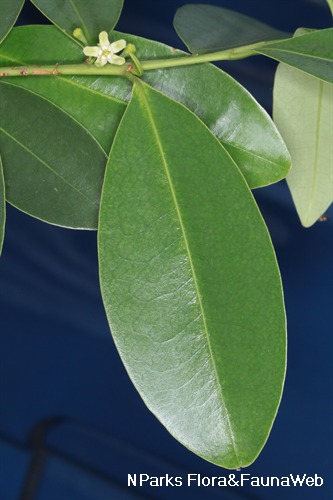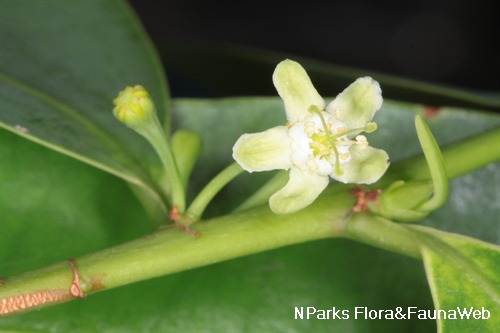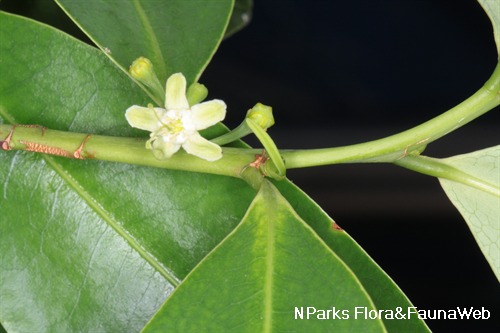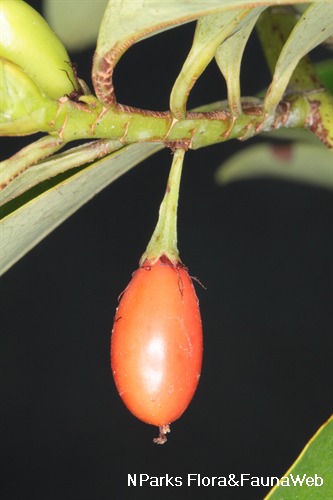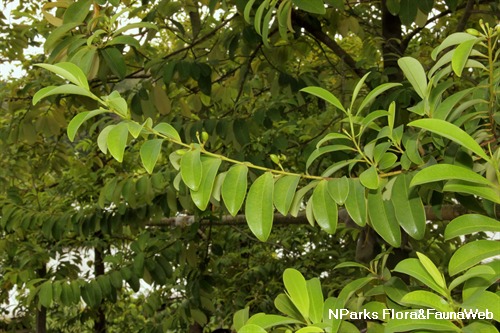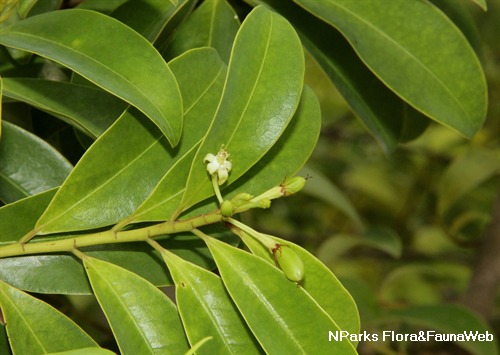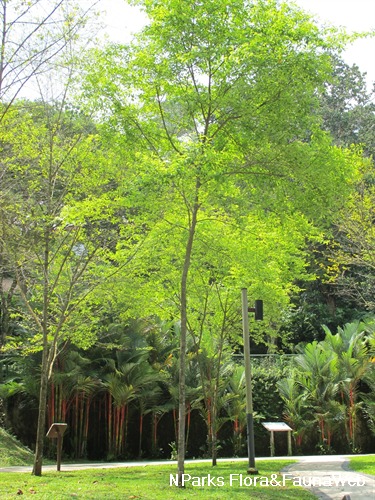
Back
Erythroxylum cuneatum (Miq.) Kurz
| Family Name: | Erythroxylaceae |
| Synonyms: | Erythroxylum burmanicum, Erythroxylum sumatranum |
| Common Name: | Inai Inai, Baka, Beluntas Bukit, Cinatamula, Mahang Wangi, Medang Lenggundi, Medang Wangi |
Name
Classifications and Characteristics
| Plant Division | Angiosperms (Flowering Seed Plants) (Dicotyledon) |
|---|---|
| Plant Growth Form | Tree (Big (>30m), Medium (16m-30m), Small (6m-15m)) |
| Lifespan (in Singapore) | Perennial |
| Mode of Nutrition | Autotrophic |
| Plant Shape | Irregular |
Biogeography
| Native Distribution | Myanmar, Vietnam, Thailand, Malaysia, Singapore, the Philippines, and Indonesia |
|---|---|
| Native Habitat | Terrestrial (Primary Rainforest, Secondary Rainforest, Coastal Forest), Shoreline (Sandy Beach, Rocky Beach) |
| Preferred Climate Zone | Tropical |
| Local Conservation Status | Native to Singapore (Least Concern (LC)) |
Description and Ethnobotany
| Growth Form | It is a shrub or tree that can grow up to 45 m tall, and with flattened green twigs. |
|---|---|
| Trunk | Bark brown in colour, narrowly ridged and fissured. |
| Foliage | Its alternate, stalked leaves have papery to thinly leathery leaf blades that are elliptic to elliptic-lance-shaped or reverse-egg-shaped, dark green to greenish brown above, light green on the underside, and1.9–18 by 0.9–7 cm. |
| Flowers | Its tiny flowers grow in clusters of 1–8, and are white to light green, and about 6.5 mm wide. |
| Fruit | Its fruits are drupes that are ellipsoid, curved, bright red when ripe, 1-seeded, and 8–15 by 2.5–4.5 mm. Its seeds are flattened, and are 5–10 by 1–2.5 mm. |
| Habitat | It grows in primary and secondary forests, and along sandy and rocky shores, up to 900 m altitude. It is known locally in Changi, Pulau Tekong, Pulau Ubin, and St. John's Island. |
| Associated Fauna | Its fruits are reported to be eaten by mammals, such as gibbons, and porcupines. |
| Cultivation | It can be propagated by seeds. |
| Etymology | Greek erythros, red; Greek xylon, wood, referring to the red wood of the trees; Latin cuneatum, wedge-shaped, referring to its leaf base |
| Ethnobotanical Uses | Timber & Products: It
is harvested for timber. The wood is used for house posts. Cultural / Religious: Heritage Tree : There is currently one individual of Erythroxylum cuneatum listed as a Heritage Tree in Singapore. It can be found at Changi. To find out more about this tree, please visit the Heritage Tree Register. Others: The leaves of E. cuneatum are reported to be used as fish poison in the Philippines (Luzon). It is planted as an ornamental tree in parks and gardens. |
Landscaping Features
| Landscaping | It is suitable to be planted along roads, parks and gardens or in coastal areas. |
|---|---|
| Desirable Plant Features | Ornamental Fruits |
| Landscape Uses | Coastal, General, Suitable for Roadsides, Parks & Gardens, Small Gardens, Beachfront / Shoreline, Hedge / Screening |
Fauna, Pollination and Dispersal
| Pollination Method(s) | Biotic (Fauna) |
|---|---|
| Seed or Spore Dispersal | Biotic (Fauna) (Vertebrates (Other Mammal)) |
Plant Care and Propagation
| Light Preference | Full Sun, Semi-Shade |
|---|---|
| Water Preference | Moderate Water |
| Plant Growth Rate | Moderate |
| Rootzone Tolerance | Moist Soils, Well-Drained Soils |
| Propagation Method | Seed |
Foliar
| Foliage Retention | Evergreen |
|---|---|
| Mature Foliage Colour(s) | Green, Green - Light Green |
| Mature Foliage Texture(s) | Papery, Leathery |
| Foliar Type | Simple / Unifoliate |
| Foliar Arrangement Along Stem | Alternate |
| Foliar Attachment to Stem | Petiolate |
| Foliar Shape(s) | Non-Palm Foliage (Obovate, Lanceolate, Elliptical) |
| Foliar Venation | Pinnate / Net |
| Foliar Margin | Entire |
| Foliar Base | Cuneate |
| Leaf Area Index (LAI) for Green Plot Ratio | 3.0 (Tree - Intermediate Canopy) |
Floral (Angiosperm)
| Flower & Plant Sexuality | Bisexual Flowers |
| Flower Colour(s) | Green - Light Green, White, Yellow / Golden |
|---|---|
| Flower Grouping | Cluster / Inflorescence |
| Flower Location | Axillary |
| Flower Symmetry | Radial |
Fruit, Seed and Spore
| Mature Fruit Colour(s) | Red |
|---|---|
| Mature Fruit Texture(s) | Glossy / Shiny |
| Fruit Classification | Simple Fruit |
| Fruit Type |
References
| References | Corner, E.J.H. 1988. Wayside Trees of Malaya Volume 1 & 2. Kuala Lumpur, Malaysia: The Malayan Nature Society. 861 Keng, H.. 1990. The Concise Flora of Singapore: Gymnosperms and Dicotyledons. Singapore: Singapore University Press. 222 |
|---|
Image Repository
Others
| Master ID | 1590 |
|---|---|
| Species ID | 2883 |
| Flora Disclaimer | The information in this website has been compiled from reliable sources, such as reference works on medicinal plants. It is not a substitute for medical advice or treatment and NParks does not purport to provide any medical advice. Readers should always consult his/her physician before using or consuming a plant for medicinal purposes. |

